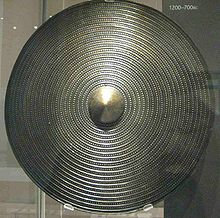The Bronze age was a time of change in terms of warfare; however, what changed was not necessarily tactics or how wars were fought, but instead a change of arsenal. In this period of human history, we see the creation of new a weapon, the use of bronze to enhance weapons that already existed. In terms of the additions, the newest weapon that was added to humanity’s arsenal in the Bronze age was the sword.

The first swords began to emerge around 1600 BCE, and many bronze age swords that have been recovered have a similar story to tell; one that speaks of heavy use in combat as seen by the damages in the blade and hilts as well as evidence of much resharpening and repair.1 In fact, one interesting discovery, which at first was rather strange, is that it has often been found that the damage on many of the swords that have been recovered typically have damage on only one side of the weapon; however, it was found that this was a shared trait among the many recovered swords. The answer to this mystery was not a hard one to find. Take for example a pencil; one will typically, without even noticing it, hold a pencil the same way every time one picks it up. After a while one may come to discover that the pencil will become dull, requiring it to be sharpened. The same thing will happen when using a sword; out of habit, the wielder will hold his sword the same way when striking or blocking while in combat, which will result in the dulling of the blade as well as the one-sided damage to the weapon requiring constant upkeep.2
All weapons share one thing in common: they are an extension of the human body. To elaborate, take for example the sword. A sword would be an extension of the arm allowing for a much greater attacking reach through slashing and thrusting movements. There is also one thing that swords, spears, and axes have in common. They can be used with one hand, and the obvious tool for the other hand would be a shield. It is understandable that one might just consider a shield as a piece of armor; but on the contrary, a shield is actually a defensive weapon, and when paired with a one-handed offensive weapon, the wielder could repeat a series of attack and defense maneuvers, such as slash and thrust then block or side step to avoid a blow, and repeat. One weapon by itself already enhances the human body’s capacity for combat, but add another, and at that one with defensive capabilities, and a skilled soldier becomes a one man army.
Shields came in many different shapes, sizes, and forms; the shield made of wood, for example was capable of taking hits and had a good resistance to blades. The leather shield was not much different from its wood counterpart though it was very light and more flexible; however, shields made of bronze had a much higher rate of survival than their organic made counterparts. They had much higher resistance to damage and breakage, ultimately leading to the wielder being in slightly less danger than if he were using lesser shields. Yet with the defensive advantage that bronze shields had over wood or leather came a slight drawback, a shared trait with any bronze weapon; they had additional weight to them.3 This additional weight would have hindered mobility just a bit compared to weapons not made of bronze, but that was a fair price to pay for a better defense and survival rate in the long run.
The bronze age would eventually come to an end, and weapons would be made of iron as the following era’s name suggests, the Iron Age. From this point on weapons would continue to evolve, warfare would be revolutionized by the Assyrians, the Greeks, and the Romans in the following age. However, one thing will always stay the same; that is that war would be a constant occurrence throughout human history for many reasons, and humanity’s ever growing arsenal would continue to expand.
- Barry Molloy, “For Gods or Men? A Reappraisal of the Function of European Bronze Age Shields,” Antiquity 83, no. 322 (December 2009): 1053. ↵
- K. Kristiansen, “The Tale of the Sword – Swords and Swordfighters in Bronze Age Europe,” Oxford Journal of Archaeology 21, no. 4 (November 2002): 323. ↵
- Barry Molloy, “For Gods or Men? A Reappraisal of the Function of European Bronze Age Shields,” Antiquity 83, no. 322 (December 2009): 1053-1055. ↵



34 comments
Anayeli Prieto
Great article! I really likes the comparison of the sword to the pencil and how you mentioned that there will always be one side that will be more worn out than the other. I also really liked he point where you mentioned that the sword is an extension to the body. It definitely provides a safer feeling in any war or battles rather than to have nothing. I am also really amazed as how the weapons that we use have evolved so much and how they become stronger and more dangerous and the fact that we depend so much on them to solve all of our issues.
Aimee Trevino
Really interesting article! I always thought the Bronze era was when they first introduced weapons like swords and shields. I really liked how you compared the swords to a pencil. That descriptive part really helped me visualize the explanation, and made it a lot easier to understand. I also liked that you described weapons as having been invented to be an extension to the body, as I had never known or thought of that.
Johnanthony Hernandez
Interesting article, I didn’t know that many of the bronze weapons recovered had damage and repair to pretty much one side. I knew that bronze is a weaker metal and that it does require a lot more maintenance than its iron and eventually steel counterparts. The idea that a person would subconsciously use practically one side contentiously is something that never entered my mind. To me, I would have thought that they would use one side for defense and one for offense, not just one side for both.
Erick Martinez
Great article, you did a great job of expanding on this topic. It is always great to learn more about the evolution of weapons used in battle. You demonstrated the importance of bronze weapons, in comparison to what was previously used, as well as how it led to the development of iron weapons. Thank you for sharing this awesome depiction of early weaponry.
Justin Sassman
A very interesting article about the birth of the sword, one of the bronze age’s greatest gift to us and how it was an extenison of ones self if used properly. i like the similar connection you made with a pencil, to think we all hold our pencils and swords the same way all the time, also to learn about how one can use the shield and sword to be a basic one man army was a cool plus of information along with the details of different type of shields
Samuel Sanchez
Good article. I liked how you gave examples comparing a sword to a pencil. I liked the information you provided especially when it came to the comparison of the shields. I would have liked more information about the Iron Age, it would have been a good comparison as well. Overall, it was informative on the weapons. Keep up the great work.
Yesenia Cardenas
Great article. I really enjoyed your example of a pencil and linking it to a sword. Everyone did what they could to get the military edge back then, as well as today.
Tina Valdez
There is so much to weaponry that I imagine it was difficult to deliver the information concisely and efficiently, however you did it well. I did a considerable amount of research on Assyrian weaponry and therefore the Iron Age, so I enjoyed reading about the details of weapons previous to that. I enjoyed your explanation of weapons being an extension of the human body, that painted a fantastic picture for your readers. There are still many similarities between Bronze age weaponry and Iron Age weaponry. Great article!
Salvador Rodriguez Gomez
For some reason I thought swords were around much earlier but now I know they have only been around since the bronze age. It’s cool to see how copper changed combat by resulting in the creation of the sword and shield. It’s also cool and makes sense that weapons like swords were seen as an extension to one’s body.
Maalik Stansbury
I love the part about the swords. I am really intrigue with how we came up with this and before what instruments and tools did we use. I realy did love the infomation you put it reminded me of karate when we had to train with katanas, making that an extension of our self. GReat job on the article overall, including the information